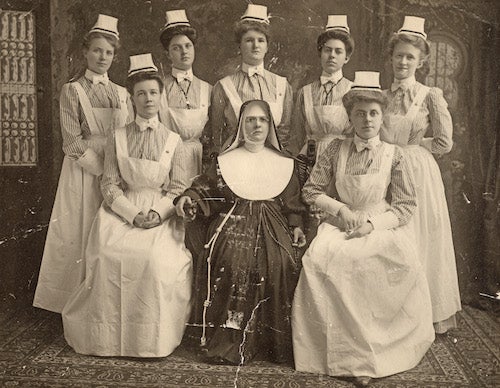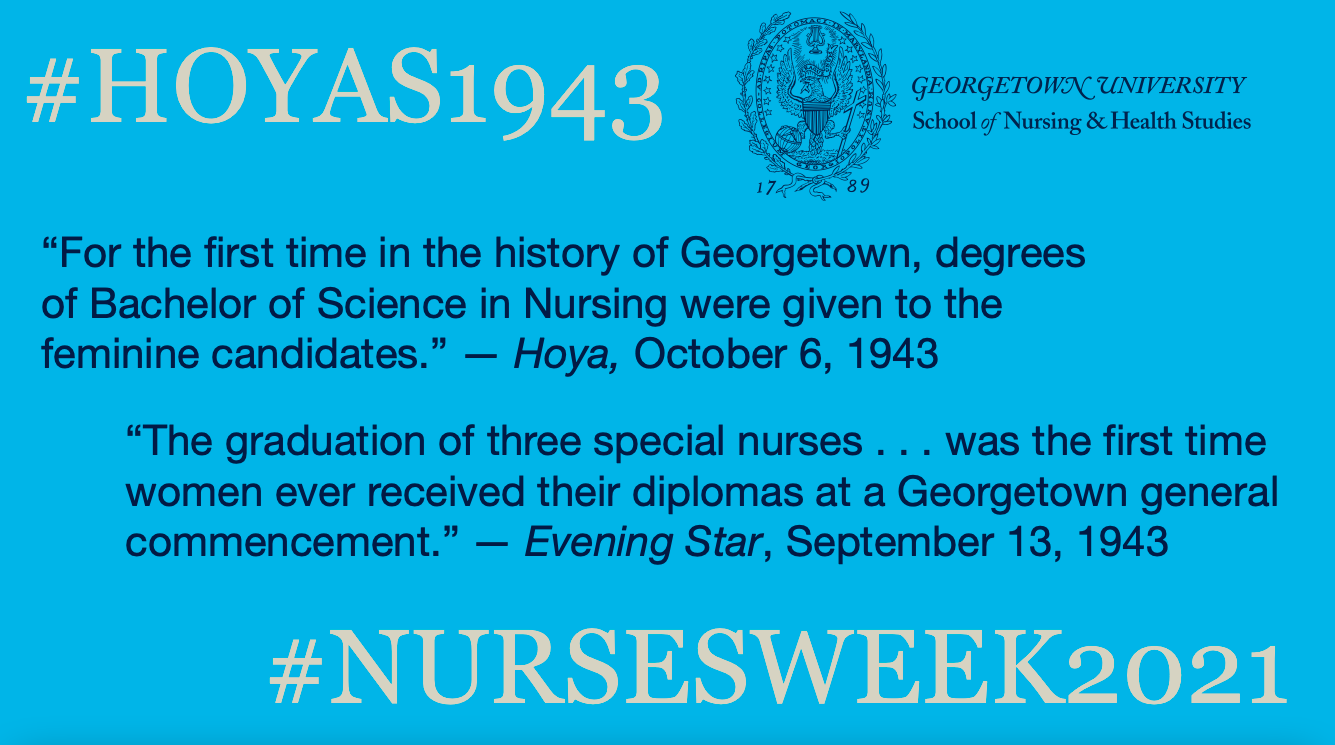Almost 80 Years Ago, Three Women Received the BSN at Georgetown’s Graduation
May 11, 2021 – Nearly 80 years ago, at a late-summer ceremony, three women were awarded their bachelor’s degrees in nursing at Georgetown University’s Commencement.
The September 12, 1943 afternoon event included Margaret Ludmilla Dudas, Eva Lucille Stevens, and Marie Antoinette Troxell, whose names were listed with the men graduates of the College of Arts and Sciences in the Commencement program. They came under the subheading “Bachelor of Science in Nursing.” (Visit the 1943 Commencement program.)
The next day, the Evening Star claimed some history from this moment: “The graduation of three special nurses—Margaret Ludmilla Dudas, Eva Kucille [sic] Stevens and Marie Antoinette Troxell—was the first time women ever received their diplomas at a Georgetown general commencement.”
And the October 6, 1943 issue of the Hoya contributed context with a front-page headline reading, in part, “Nurses Were Given Degrees Along with Rest of University,” and the corresponding story reporting, “For the first time in the history of Georgetown, degrees of Bachelor of Science in Nursing were given to the feminine candidates.”

Double Hoyas
Beginning in 1906, the Nursing School had recognized graduates – all women – of the three-year diploma program at a separate ceremony on campus, according to a review of some contemporary news articles, which often listed the graduates’ names.
(Sometimes, the Nursing School held a joint ceremony with Providence Hospital or Georgetown’s one-time dental hygienist program.)
Following that model, in the mid-1930s, the three 1943 BSN degree graduates had received their GU nursing diplomas: Stevens in 1936, according to a May 29, 1936 article in the Evening Star, and Dudas and Troxell in 1937, as reported by the Washington Post on May 28, 1937.
Stevens – a wedding announcement in the Harrisburg (Pennsylvania) Telegraph on January 9, 1945 reported – was working at Georgetown University Hospital as an operating room administrator.
Troxell’s 1987 obituary in the Washington Post noted she served for nearly three decades on the staff of Bethesda Naval Hospital. Dudas’ 1990 obituary in the Valley Independent (Monesson, Pennsylvania), while not mentioning her Georgetown education, highlighted her service in the United States Army Nurse Corps with the rank of first lieutenant.
It is likely that the three graduate nurses (that is, diploma-prepared registered nurses) went on to receive their bachelor’s degrees at Georgetown in the next decade through a model of “extension courses.”
Extension Courses
Further, the three seem to be the unnamed women that Father John E. Grattan, SJ, dean of the College of Arts and Sciences, was writing about on July 14, 1942, to his successor Father Stephen McNamee, SJ.
“This memo deals with the ‘Extension Courses’ conducted in the Georgetown Hospital for the benefit of the graduate nurses as well as for the Sisters of St. Francis,” Grattan noted, explaining that interest in the extension option had been disappointing and that the College was continuing to offer coursework “simply to fulfill our moral obligation to certain graduate nurses who have taken the majority of their work towards a degree.”
Grattan indicated the degree-seeking students – who would finish their classes the coming May in time for graduation that fall – would take some coursework on campus. He advised, “The flutter over ladies on the campus will not be of long duration, and I suggest that no notice of their presence appear in ‘The Hoya’ or be given any publicity.”

The College and Nursing
In the 1943 Commencement program, McNamee, the College dean, is listed, along with the leadership of other schools, as presenting “candidates for degrees in course.” No nursing academic leader was included, nor did the School of Nursing have faculty or student marshals.
The Evening Star article printed the women’s names under the College just as the Commencement program did. However, the piece did mention, “Among the graduates yesterday were 39 in the college, three in the school of nursing . . . .”
In the 1940s, as a written history and documents show, the School of Nursing – as it was moving from a hospital-based to a collegiate, standalone school – was considered a part of the College of Arts and Sciences.
So while the women were listed in the graduation program and the Evening Star with the male College graduates, perhaps a distinction was made at the event itself about the relationship between the two Georgetown schools.
That said, in May 1943, the School of Nursing did host a separate Commencement in Gaston Hall for nearly 30 diploma graduates, a contemporary Washington Post article shows. (Learn more about the relationship between the College and the Nursing School.)
GU Women’s History Firsts
It seems the campus first that Dudas, Stevens, and Troxell achieved nearly 80 years ago involves being the first women publicly recognized at a Georgetown Commencement (and within the corresponding printed program) for having received a bachelor’s degree on the campus.

They may also be the first women officially recognized at a Commencement as bachelor’s graduates of the College of Arts and Sciences, again through its one-time closer relationship with the Nursing School. (In 1935, master of arts graduate Sister M. Baptista Klein, VHM, is listed in the Commencement program under the Graduate School section of the College of Arts and Sciences.)
Finally, it may be the first time that nursing was included in Georgetown’s university-wide Commencement celebration.
From 1945-1948, women who earned the BSN continued to be listed under the College of Arts and Sciences, according to archived Commencement programs, with women who had received the three-year diploma being included elsewhere in the same publications under the School of Nursing. In 1949, that changed, and the BSN graduates were moved under the Nursing School, and diploma graduates no longer listed.
1944, according to that year’s Commencement program, also appears to be the first year that nursing students and faculty – Sister Joanilla Knott, OSF (school director and double alumna – Diploma 1916, BSN 1926), Margaret H. Middleton (student marshal), and Kathleen A. Leonard (reception committee) – were involved in aspects of the event.
(A more thorough review of GU print programs and other digitized and non-digitized records would help solidify these historical “firsts.” Some Commencement programs are not among the library’s digital collection.)
Women first graduated from the School of Foreign Service in 1946, the School of Medicine in 1949, and the business division of SFS (later the School of Business) in 1951, a timeline about women’s history on campus describes.
By Bill Cessato
The author thanks Lynn Conway and Ann Galloway in the Georgetown University Archives for their time with requests for information. Conway also provided a photo of the Hoya article from 1943, which the author hoped to see to determine if the reporting matched the Evening Star piece.
Read Dr. Alma Woolley’s Learning, Faith, and Caring: History of the Georgetown University School of Nursing, 1903-2000 (2001) and Dr. Robert Emmett Curran’s History of Georgetown University: The Quest for Excellence 1889-1964 (2010) for information about extension courses, university administrators, the relationship between the College and the School of Nursing, and other related topics.

